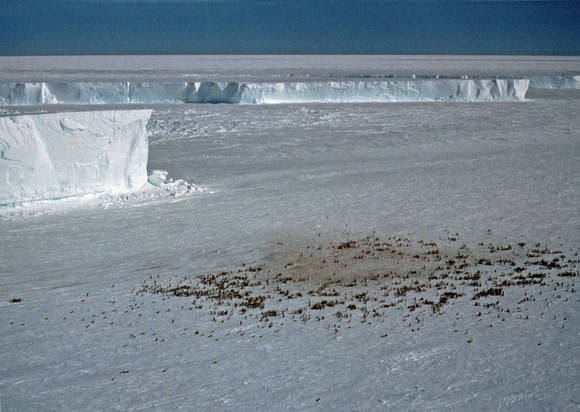This just in from the 'things kids can giggle about' department: British scientists are using satellite images to find colonies of emperor penguins in Antarctica. While their natural camouflage makes them blend into the shadows of the sea ice where they breed, their droppings, or guano, show up perfectly from space. "We can't see actual penguins on the satellite maps because the resolution isn't good enough," said mapping expert Peter Fretwell. "But during the breeding season the birds stay at a colony for eight months. The ice gets pretty dirty and it's the guano stains that we can see."
[caption id="attachment_31896" align="aligncenter" width="580"]
Stains on the ice visible on this satellite image. Credit: British Antarctic Survey[/caption]
Emperor penguins spend a large part of their lives at sea. During the Antarctic winter when temperatures drop to -50°C they return to their colonies to breed on sea-ice, but this is a time when it is most difficult for scientists to monitor them. Knowing their location provides a baseline for monitoring their response to environmental change.
Reddish brown patches of guano on the ice, visible in satellite images, provide a reliable indication of their location.
British Antarctic Survey Penguin ecologist Dr Phil Trathan says: "This is a very exciting development. Now we know exactly where the penguins are, the next step will be to count each colony so we can get a much better picture of population size. Using satellite images combined with counts of penguin numbers puts us in a much better position to monitor future population changes over time."
[caption id="attachment_31897" align="aligncenter" width="205"]
Emperor penguin. Photo credit:
Samuel Blanc
[/caption]
The method helped scientists identify 38 penguin colonies -- of those, 10 were new. Of previously known colonies, six had re-located and six were not found. Estimates put the total number of penguins at between 200,000 and 400,000 breeding pairs.
Source: British Antarctic Survey
 Universe Today
Universe Today
